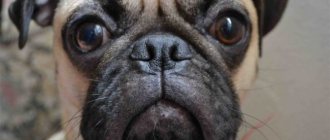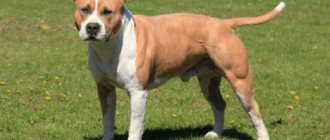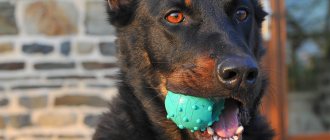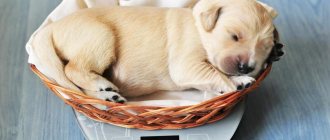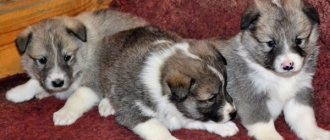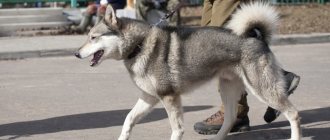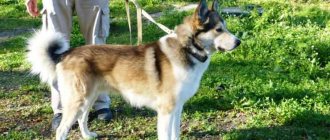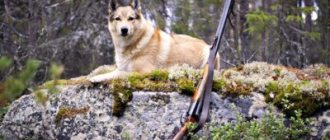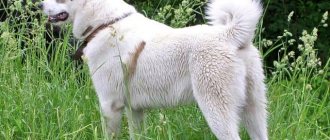The East Siberian Laika is the largest hunting dog breed among Laikas, bred in Russia. They are adapted to the harshest conditions, including Siberian frosts and taiga climates.
The ancestors of dogs of this breed lived in the vastness of the Urals and Siberia, over time they changed and became more resilient.
To the question - where to buy an East Siberian Laika, we will answer below.
History and purpose of the breed
The East Siberian Laika belongs to a large group of breeds, the development of which took place in a limited area. The vast expanses of the Russian North had practically no roads, and the indigenous inhabitants: Evenks and other small nationalities, were engaged in hunting fur-bearing animals, taking local dogs as assistants. Laikas are a common group of primitive breeds that have always lived in Siberia and Alaska. They helped people transport heavy loads and hunt animals, and due to the remoteness of settlements from each other, as well as the inaccessibility of most areas, breed groups multiplied “in themselves.”
Thus, in each region of the North its own special breed of huskies was formed. The East Siberian Laika carries the blood of Evenki and Tunguska dogs, and has always been a true assistant and friend of the hunter. Already in the nineteenth century, this breed was presented at Moscow hunting exhibitions, but a temporary breed standard was adopted only after the Great Patriotic War.
Folk breeding of huskies of this breed was chaotic, did not take into account small details of the exterior, but always aimed to preserve and enhance the hunting qualities of the descendants. The breed became even more interesting for breeders who created nurseries in an effort to study it. The city of Irkutsk became the breeding center in the USSR, where all the best individuals of the East Siberian Laika at that time were concentrated.
Twenty years later, commercial nurseries created by order of the authorities produced huge quantities of furs. In 1980 the breed was recognized by the Fédération Cynologique Internationale, and in 1989 the final breed standard was adopted. But the tragedy of the East Siberian Laika is that with the collapse of the USSR, the nurseries collapsed, most of the dogs were sold to China, and no one particularly looked after the purebred of the remaining individuals. At the beginning of the new century, only about 40 puppies were born in the RKF per year, which is very little for the development of the breed.
After the collapse of the USSR, the breed was practically lost. Today it is rare to meet a real East Siberian Laika; most purebred dogs do not attend exhibitions, but are used only as hunting dogs. The fact that this dog is not a companion and is almost never kept in the city sharply reduces the popularity of the breed.
Pros and cons of the breed
| + | – |
| Suitable for hunters and sports people | Quite a rare breed of dog |
| Well trained | Not suitable for apartment living |
| If trained correctly they can be companions | Does not get along well with cats, rodents and birds |
| Good with children | Requires professional training |
| Neutral towards strangers | Requires a high level of physical activity |
| Unpretentious in conditions of detention | |
| Have good health |
Laikas are hunters by nature. They need an owner-leader and constant stress. This dog will not be happy lying on a rug in the hallway. Her calling is to follow the trail, to be on the move, to hunt. Therefore, before you get a husky, you need to soberly assess your own capabilities.
Appearance Features
Representatives in terms of weight and height are included in the category of medium breeds. The average height of males is from fifty-five to sixty-four centimeters; for females these values range from fifty-one to sixty centimeters. The dogs weigh from eighteen to twenty-three kilograms.
East Siberian huskies have a strong build with well-developed muscles and bones. They have a wide chest and a straight back. The tail is long, curled up on the dog’s hip or hanging over the back in the shape of a sickle. In a straightened state, according to standard breed standards, the tail should reach the level of the hock joint; deviations from the criterion by two centimeters are allowed.
- German Shepherd
- What kind of snakes are kept at home?
- Ancient dog breeds
- Dog's sense of smell
- Maine Coon
- Domestic iguana
The head has a wide skull. The shape of the muzzle is close to wedge-shaped, with a scissor bite. The ears are located at eye level and have the shape of a triangle with equal sides. The ends of the ears are most often rounded, although you can find representatives of this breed with pointed tips of the ears.
The fur of East Siberian huskies is quite long, thick with a well-formed undercoat, which maintains the dog's body temperature, protecting its body from strong temperature changes. In the neck area, the animal's hair is longer and thicker; it creates a so-called collar, which gives the dog a characteristic appearance. Males have a scruff at the withers. Animals shed at least twice a year.
Description of the breed
The East Siberian Laika is a large, well-built dog with a slightly elongated body and strong bones. Ideal for hunting and physical labor.
Breed standard:
- Dimensions: height – up to 64 cm, weight – up to 23 kg.
- Elongated wedge-shaped head. The skull is wide and powerful, with a rounded occipital part. The length of the muzzle is almost equal to the length of the skull. Soft transition from forehead to muzzle.
- The ears are medium set, erect. They have a pointed or rounded shape at the ends, located at eye level.
- The eyes are medium-sized with an oval or soft oblique slant. The iris is colored brown.
- The teeth are large, well developed, scissor bite.
- The nose is large and wide. The nostrils look harmonious.
- The neck is strong, with pronounced muscles. Its length is almost equal to the length of the head.
- The withers are clearly defined. The back is wide and straight with well-developed muscles.
- The tail is curled into a ring and curled over the back. Sometimes it presses against the thigh.
- Limbs are strong, straight and parallel. The paws form a lump.
Laika moves quickly and energetically. The gait is easy. The typical gait is an accelerated trot and a soft gallop.
Coat and colors
The coat is abundant and has a hard texture. The undercoat is soft and dense. In the area of the legs, head and ears the pile is short. It forms a lush muff on the neck and shoulders, and is moderately long on the inside of the legs.
Typical colors include:
- white;
- redhead;
- black;
- black and tan;
- gray;
- piebald;
- brown (brown color can be of various shades).
If the husky is colored brown, merle, blue and saddleback, it means it has crossed with other breeds. This is a violation of the standard.
How does the East Siberian Laika differ from the West Siberian Laika?
The variety of husky breeds and small breed differences between them often lead to controversy. So how does the East Siberian Laika differ from the West Siberian Laika? Is there a big difference in the exterior and character of the two Laikas?
The difference between the East Siberian Laika and the West Siberian is its color.
- The most striking difference by which a dog can be accurately identified as belonging to a particular breed is color. The East Siberian Laika is famous for its elegant caramel color, otherwise called black and tan. Dogs of this breed can also be black. In West Siberian Laikas, black or black and tan colors are unacceptable and are a defect in the exterior.
- Dimensions. Easterners should be larger than Westerners; the difference in height at the withers is approximately three centimeters. Accordingly, the East Siberian Laika has a larger head, more powerful bones, and a stretched body format. The West Siberian Laika is sleeker and smaller, its format is close to a square.
- Physical data. Endurance is one of the advantages of Orientals; these huskies can pull a team, tow a skier, or chase an animal. Westerners are not harnessed to sleds, but they are also tireless in pursuit of the beast.
- Ear shape. The pointed tips of the ears of the ZS Laika are a mandatory breed characteristic, while the ends of the ears of the BC Laika may be rounded.
- Character. The East Siberian Laika is considered to be softer in character, compliant and shows almost no aggression towards humans. She is not inclined to dominate, while the West Siberian often shows character.
Diseases life expectancy
The East Siberian Laika is a healthy and hardy breed. Native Siberians are not prone to any diseases, but puppies raised in nurseries do not have such strong immunity. They are characterized by:
- plague;
- rabies;
- enteritis;
- retinal atrophy;
- clouding of the lens of the eye;
- diseases of the oral cavity.
Average life expectancy: 12-15 years.
Comparison of breeds
The East Siberian and West Siberian Laika developed in similar natural conditions, so they are difficult to distinguish. Often this can only be done by specialists.
The most obvious differences include:
- Exterior. Easterners have a massive and elongated build. They stand out for their menacing appearance and powerful jaws. Westerners have a more modest size and are distinguished by their leanness. Their ears are set high and pointed at the ends. Easterners have medium-set ears with rounded tips.
- Color. The Western European Laika is characterized by a black and black and tan coat. Easterners do not have this type of color.
- Character. Easterners are less inclined to suppress the owner. Westerners are known for their cunning and dominant nature.
Both breeds are excellent hunting dogs, tolerant of children and strangers (in their territory), loyal to their owner and easy to train.
Character and hunting qualities
East Siberian Laikas are true Russian hunting dogs with a highly developed orientation reflex. This feature means that they easily adapt to the environment during their growth period. That is, despite the fact that these dogs were bred in the north, they can easily adapt to a different climate without compromising their health.
Owners of East Siberian Laikas note such qualities in their pets as agility, agility, stamina, and masculinity. They love movement and show their best qualities during hunting, a craving for which is in their blood.
In many ways, this breed is universal for hunting. It can be tested to work on different animals, especially the East Siberian Laika has a tendency to hunt sable, ungulates, lynx and bear. Masculinity, endurance, physical strength, lightning speed of reaction make this breed an indispensable assistant for a hunter.
Although malice towards humans and aggressiveness are not typical, the East Siberian Laika can also be used as a watchman, who will notify the appearance of strangers with a loud bark.
Dog character
Unlike West Siberian huskies, the eastern breed is more focused on its owner. They are easier to train and do not try to dominate.
If you show your puppy your leadership qualities, he will remain devoted and faithful for the rest of his life.
The hunting qualities of huskies are excellent. They are even capable of chasing elk and bear.
Note!
Nicknames for dogs for boys - easy, rare and most beautiful names for dogs in alphabetical order
Nicknames for girls' dogs - a list of beautiful, funny, unusual nicknames for large and small dog breeds
Maltipoo dog - everything about the dog from A to Z. Photos, description of the breed, character, maintenance features, prices, reviews
During the hunt, they demonstrate amazing endurance and fast movement. These dogs do not know fear, they are distinguished by courage and masculinity.
They demonstrate anger and aggression towards wild animals, kindness and tenderness towards the owner. They are not aggressive towards people. They loudly notify the owners of the approach of visitors.
Health of the East Siberian Laika
Laikas are strong dogs. Their immune system was formed through selection under harsh natural conditions. As such, no genetic diseases have been identified in the breed. Breeders note that on average, working East Siberian huskies live from twelve to seventeen years, which is a very long time for this breed.
The biggest problem of all hunting dogs is a lot of injuries. These huskies have a very dangerous job. When a dog is excited, he often stops noticing many things and even ignores them. For example, when working with a boar or a bear, males behave more fiercely and aggressively, but females are smarter and more careful.
Therefore, a larger percentage of male dogs receive serious wounds from animals. If your dog is injured, it should be carefully bandaged with an bactericidal bandage and placed on a blanket. After placing the dog in transport, you must urgently call the veterinarian and describe the symptoms. Often the owner is in a panic and does not know what to do. Before delivering your pet to the clinic, the doctor can consult him by phone. Laikas need vaccinations and antiparasitic procedures.
Origin of the breed
The breed is classified as aboriginal. It formed independently as a result of natural selection and has never been subjected to selection. The first information about East Siberian huskies began to appear in the 19th century during the development of the territories of the Far East and Siberia. The first standard was adopted in 1949, and then in 1980 it was adjusted and remains in effect to this day.
In the 60s of the 20th century, the first people appeared who wanted to engage in breeding work in order to improve the breed's qualities (a nursery was opened in Irkutsk). In the 90s, many nurseries closed, purebred individuals became lost, perhaps mixed with mongrels. Now East Siberian Laikas are in the process of restoring their numbers, and the breed is still very far from regaining its former popularity. But enthusiasts and simply lovers of these dogs are making every effort to bring their charges to the proper level.
The main purpose of the East Siberian Laika is hunting.
How to properly care for the East Siberian Laika?
If the dog is in an enclosure, then caring for it will not be very difficult.
But in apartment conditions everything will be more complicated, since there are a number of factors :
- such a dog really needs movement and space;
- There is intense shedding, so the thick undercoat will remain on the carpets.
It is not recommended to have a pet of this breed in the following cases:
- if you are accustomed to a measured and calm lifestyle;
- if you spend a lot of time outside the home;
- do not like hunting and active recreation.
Even if you are not a hunter, but simply love activity and are ready to walk with your pet for a long time, you can safely get such a husky.
Many people believe that such a dog will act as a stern guard. But in reality this is not the case, since they are mostly indifferent to strangers, and in some cases even sympathize with them.
Representatives of this breed are generally in good health and do not suffer from hereditary diseases. Moreover, such a dog, compared to other decorative and service species, can digest food better and eats as much as it needs. This feature is very useful, especially in extreme situations, in particular during long hunting trips with a dog. At other times, the animal must be fed according to the usual schedule - twice a day for an adult. A distinctive feature of the breed is that it is not picky in terms of nutrition, which is very good for the owner.
Features of wool
The description of the East Siberian Laika breed includes the characteristics of the coat, its texture and color. They have a very thick, two-layer coat with a soft, dense undercoat, but the coat itself is hard.
There is a fur collar on the shoulders and neck. Laikas can be black, red, white, and have various inclusions and spots.
Most often, the East Siberian Laika has a luxurious black and tan color. Males have longer hair on the nape.The presence of an undercoat allows this breed to withstand even the most severe and severe frosts, preventing them from feeling cold and chilly.
Optimal diet
The East Siberian Laika eats little. The number of meals should be appropriate for their age. Puppies are fed 4-5 times a day, adult dogs 2 times. Make sure that your dog does not overeat, this leads to disruption of the digestive system and can even lead to obesity. The main product in the diet should be meat. Beef, veal, and poultry are suitable. It is better to serve meat boiled. Be sure to include fish in your diet.
Don't forget about vegetables as a valuable source of vitamins and minerals. It is better to give them in crushed form and add to meat. At the same time, your pet will receive more vitamins if the vegetables are raw. It is also very useful to give your dog fermented milk products (cottage cheese, sour cream, kefir) to strengthen the skeletal system.
To strengthen the teeth, the dog is given bones and tendons. This way, your pet will happily satisfy its need to chew and receive a supply of salts and minerals. It is better to boil the bones; in their raw form they are poorly digestible. You definitely need to buy vitamins for dogs; taking them will help replenish all the missing elements. Also, make sure that there is always clean drinking water near your food bowl.
It is strictly forbidden to feed:
- confectionery products;
- smoked meats;
- spices, seasonings.
Small puppies up to 4 months of age need exclusively milk and first complementary foods; they are not given fermented milk products. It is not advisable to feed these dogs dry food; it is unnatural for their natural habitat. Dry food can be used as a reward.
Breed Features
Previously, they were called exclusively “northern wits.” It was the sharp ears that clearly distinguished this dog from the dog tribe. Laika is a kind of prototype of the Spitz; as a separate species, it became of interest to dog handlers only in the 19th century. However, many difficulties arose in the classification, since the diversity of animals was amazing - so many nationalities, so many varieties. Nevertheless, the result was summed up: the breed was divided into two main groups. This division was literally correlated with geography. The main standards were announced only in 1952.
To what age do they grow?
The puppy begins to grow up very early, and by 18 months it turns into a full-fledged adult dog. This period is enough for adaptation, education and study, which is carried out in several stages “from simple to complex.” However, it is sometimes too early to talk about final maturity at 18 months. A large individual can grow up to 3-4 years, which depends on the species to which it belongs.
The husky matures gradually, overcoming several periods:
- neonatal - the period of infancy, when the puppy needs warmth and good nutrition, it lasts until the 12th day;
- transitional - a period of obvious physiological changes: the eyes open, the first teeth appear, the puppy stands on its paws and begins to move, lasts until the 20th day from the moment of birth;
- the period of understanding - when the puppy begins to feel like a part of the world, a very important period, at this moment the psyche is formed, separation from the mother at this time is unacceptable, lasts until the 28th day from the moment of birth;
- socialization - the period when the puppy becomes a dog, subject to the necessary discipline, it lasts until the 7th week from birth;
- “human” socialization - the period when a connection with a person is established, the most favorable for introduction to the future home, corresponds to 7 - 12 weeks from the moment of birth;
- the period of exposure to fear - the period when the baby is very timid, afraid of everything new, special attention is required here (for example, when visiting a veterinary clinic), lasts from the 8th to the 11th week from the moment of birth;
- “Age of Reduction” is a period of reduction in dependence, which coincides with a reduction in the number of teeth, at this time the puppy decides for itself the issue of leadership, the duration of the period is 13-16 weeks;
- instinct of “flight” - the period of teething, when the puppy tries to feel completely free, the period is characterized by unpredictable actions, disobedience, it lasts about 4 months, at the age of 4 to 8 months;
- the second period of exposure to fear is another moment of growing up, fear of uncertainty, during this period patience and wisdom are required from the owner, the period occurs between 6 and 14 months;
- By 18 months, the puppy is fully formed, but does not stop growing, as mentioned above.
We advise you to read: A dog for a child - how to choose the best breed
Education and training
You shouldn’t delay raising your four-legged friend; you should start immediately as soon as he gets into the house. Otherwise, the owners will soon be faced with the pet’s stubbornness, self-will and independence.
Laikas are prone to escape, they do it so masterfully that the owner can wonder for a long time how this happened. They can make tunnels, climb over high fences and free themselves from the collar.
It is recommended that you take your pet through special obedience courses for up to six months. Thanks to competent training, the puppy will quickly begin to perceive the owner as a leader, become attached to him and will be more willing to obey.
Joint training and training will help the owner find a common language with the pet, understand the needs and mood of his four-legged companion, which is very important not only for normal life, but also for hunting. Traditionally, hunting dogs have only one owner. It is he who is responsible for the main concerns about the pet - feeding, walking, training. The dog must hunt with the same person.
Training of huskies begins at 6 months of age, initially using special areas for this. It is advisable if an adult dog who has been trained and has some experience works in tandem with a newly minted hunter. Laikas are excellent imitators and can adopt knowledge and skills from their brothers.
Hunting
Laika is a born hunter, whose qualities were passed on to her from her ancestors.
Therefore, you will not experience any problems taking it hunting, because it will quickly help you find killed game. Having found the animal, the dog will immediately notify you with a loud bark. During the hunt, the East Siberian Laika fully demonstrates all its useful skills - concentration, observation, agility and intelligence. Seeing how this dog behaves while chasing prey, it is easy to mistake it for a wolf. They do not create any noise while driving game and only occasionally notify the owner about the direction of movement. Little is required of the hunter - to appear at the right moment. If he is late, the husky will get ahead of him and strangle the prey .
The uniqueness of the breed is manifested in the fact that the dogs follow the animal's trail at a trot and after a while change their walk to a gallop. When you take a husky on a hunt, you don’t have to worry about its orientation on the ground, since it feels comfortable even in the forests of the taiga. Moreover, she does not need special control, since she herself watches the hunter. And therefore, you should not needlessly worry about the animal during the hunt if you do not want to be left without prey.
How to choose the right puppy?
Although dogs of this breed have certain similar qualities, they may have different inclinations and abilities. So, for some dogs, hunting can be a favorite and exciting activity, while others can be mediocre or very weak hunters. Puppies should be active and healthy. It is not necessary to choose the largest of the litter; this is not the main quality. The main thing is intelligence. If you doubt that you can choose the right puppy, invite an experienced hunter with you. It should also be taken into account that if you choose a girl, the hunt will be postponed during the periods of estrus and nursing the puppies.
The price of puppies varies depending on the availability of pedigree. It should be taken into account that purebred dogs are rare, these huskies are not very common and their cost is quite high. So, the price can start from $300. But such dogs must have an impeccable pedigree.
Puppies are also sold at a more reasonable price. So, the price may be less than a hundred dollars, but then you will not have a guarantee that it is an East Siberian Laika, the description of which is similar to other breeds.
If the purpose of the purchase is hunting, you can purchase an adult dog of this breed. The price of such pets is naturally much higher, but they will undoubtedly show their worth in business. Huskies are sold with a “narrow” focus: hunting large game, squirrels or sables. The seller may also have a video showing the dog in action.
Maintenance and care
The East Siberian Laika has earned the description as an adequate, non-aggressive, calm animal. The dog receives the approximate reflex, so to speak, with its mother’s milk.
Representatives of the breed are excellent at spatial orientation and on rough terrain. Therefore, hunting with the East Siberian Laika is possible without additional navigation equipment. The dog will always lead you to the base.
Owners of East Siberian Laikas note that their pets:
- maneuverable
- hardy
- dexterity
- active
- brave
The physical strength of eastern huskies allows them to be used not only for hunting, but also as sled dogs. In the modern world, such driving often becomes a game. So, in rural areas, Laika owners often take their children for rides on them. Representatives of the breed are tolerant of children and are an excellent option for a family dog.
Hunting with the East Siberian Laika
Outside the hunting path, East Siberian huskies serve as excellent guards. Dogs do not lie in vain, but due to their perfect sense of smell and observation, they accurately calculate the danger threatening their owners.
East Siberian individuals are not suitable as apartment dogs. The ideal place to keep it is an enclosure, and it needs a yard. There the animal will have room to move and fresh air. The owners will protect themselves from tufts of wool. East Siberian huskies shed heavily.
The owners of the breed are active people. You don't have to be a hunter. You can take your dog on hiking trips, daily jogging, or skiing. The animal needs movement. East Siberian Laikas begin to be trained at one month of age. The puppies are already ready to master the following commands in a playful way:
- Sit.
- It is forbidden.
- Lie.
- Near.
- To me.
Hunting training, or, as they say, training an animal, begins when the dog is 5 months old. They start with training them to wear a collar. It should be soft and wide. If the pet tries to remove the new thing or break out of it, you need to distract the four-legged animal. By switching attention, the dog itself will not notice how it gets used to the collar.
Having accustomed the husky to a collar, the commands learned at home are reinforced in nature. You can start training with the start of summer, so that by the end of it you can start training your pet on a squirrel. By autumn, she focuses on preparations, often moving along the ground. The abundance of tracks and the abstraction of the animals help the young husky get used to the role of a hunter. The dog watches the squirrel, barking to show its owner where to look for prey.
The squirrel is, so to speak, test prey. After a like, he easily masters hunting ungulates, martens, and arctic foxes. Desirable:
- let the pet be paired with an experienced husky, so that the young dog learns by example
- in the absence of an experienced husky, hang the carcass of an already killed squirrel from a tree, laying an artificial trail to it
Initial training on already killed squirrels will make the task easier for the husky. The main goal in the initial stages of training is only to awaken the hunting instinct.
From the age of 10 months, the East Siberian Laika can be trained to ride martens. They go hunting for moose and other ungulates with dogs that have reached the age of one and a half years. Dogs are capable of driving bears from the age of 2 years.
Price of the East Siberian Laika
The purebred East Siberian Laika is currently not a popular or very common breed, so it is not too easy to acquire a true breed representative.
As a rule, for this purpose, information about planned matings is monitored in advance and regularly on the websites of well-established nurseries. It is also advisable to attend exhibitions and hunting dog competitions, where you have the opportunity to directly meet the breeders of the East Siberian Laika.
The minimum cost of such a puppy is 25 thousand rubles, but the most promising pets are sold for much more . When purchasing an adult dog, all its main characteristics and work achievements must be taken into account. It should be noted that East Siberian huskies, which work in hunting large animals, cost approximately three times more than the so-called “squirrel cats” and “sable cats”.
Likes
Pointed ears, thick fur, a piercing, sad, slightly pensive look, a ring tail, a strong physique - the first thing that catches your eye. It is difficult to find a replacement for such an animal in the northern latitudes, because this is a real hunter who is taken with them to hunt bears, fur-bearing animals, game and other forest animals. This dog is endowed with remarkable intelligence and the ability to survive in extreme conditions. Thanks to such qualities, the ancient breed has come to our century almost in its original form. In general, the concept of “husky” is very broad, since there are many varieties that differ from each other in color, size, etc. For example, the Tungus dog is very different from the Karelo-Fin, etc. Some individuals are medium-sized dogs (38 cm in withers), others - to larger ones (63 cm at the withers). The largest representative of the breed is the East Siberian variety.
Owner reviews of the East Siberian Laika
Michael
These are natural hunters, universal dogs, they work on any animal - even a pheasant, even a bear! They are not afraid of anything. But I am against such dogs living in an apartment - they are free animals who love to work.
Nikolai
This is a dog that is characterized by independence and perseverance. She will go without hesitation even towards a bear. Easy to learn. Puppies are expensive, but they are worth it - my husband is a hunter, I know what I’m saying.
Lera
No matter what they say, VSL lives in our apartment and feels great. Her husband goes hunting with her and always returns with prey. The dog gets along well with children and is very smart - he never even pulls on the leash outside.
Sofia
My review of the East Siberian Laika will be only positive. The dog easily gets along with a large family and treats children with special reverence, but there will only be one owner. Education will fall on the shoulders of the head of the family. These dogs will not get along with cats, hamsters, parrots and you should not insist. If you already have a cat living in your house, with the right approach, the animals can be accustomed to each other.
Ivan
East Siberian huskies do not require special care, but if you decide to have a dog in an apartment, you need to take into account that there will be a lot of hair. When spring comes, animals will shed all their fur; dogs shed especially intensely. In winter, do not touch the fur, except perhaps comb it with a sparse comb. In the summer, regularly examine your skin for dermatitis and parasites. Preventive treatment for fleas, ticks and worms is a very important aspect of caring for any animal. With the curiosity inherent in Laikas, your pet will definitely examine all the bushes, holes and holes, and quite rare species of parasites can live in such shelters.
Video
Character
The East Siberian Laika is a strong and independent dog. She is designed for hard work and is not suitable for being a couch pet. The owner of the husky must have unshakable authority and have been involved with it since childhood. For large breeds, socialization is of decisive importance.
Easterners are dogs of one owner. Before other family members begin to give commands to the pet, they must be learned with the owner.
A husky can make a wonderful companion. She becomes very attached to her owner and has a hard time with a change of owner. You should not buy an adult, albeit trained, dog: it will miss its old family and may not accept the new one.
Easterners are kind to children and will not harm them. With proper upbringing, they can get along with cats, but such cases are quite rare. Cats, parrots and rodents are potential game and therefore are at risk.
Aggression towards humans is not typical for huskies. They are often used as watchdogs, but not always successfully. Easterners are loyal to strangers in their territory. But as soon as the dog leaves the property, it will become suspicious and wary. You need to take this trait into account when walking and avoid contact with passers-by.
Brief history of origin
The East Siberian Laika is a native Russian hunting breed that has become widespread in Central and Eastern Siberia.
Many types of huskies became its ancestors:
- Baikal;
- Amur;
- Tunguska;
- Yakut.
The breed was formed in isolation for a long time. The selection proceeded naturally: in the difficult northern conditions, only the strongest and most adapted individuals survived.
In 1947, at the All-Russian Cynological Meeting, the East Siberian Laika was declared an independent breed. 5 years later, the canine council of the Main Hunt of the RSFSR approved a temporary breed standard, and by 1981 the document was finalized and the final version was published. A year earlier, these animals were recognized by the International Film Festival.
On a note. Another name for the breed is the Far Eastern Laika.
Vaccinations and susceptibility to disease
Timely vaccination is an essential part of caring for any animal. East Siberian Laika puppies are vaccinated at 8–9 weeks from:
- carnivore plague;
- parvovirus enteritis;
- leptospirosis;
- viral hepatitis;
- parainfluenza.
After 3-4 weeks, the puppy is vaccinated again with the addition of a rabies vaccine. Adults are revaccinated annually and treated against worms and blood-sucking parasites every 3 months.
The animals are hardened by the harsh conditions of Siberia, so they do not suffer from hereditary diseases. While hunting, a dog can catch distemper or rabies, but vaccinations protect against these diseases. If the owner takes proper care of the pet, the East Siberian Laika will live 12–15 years.
Sizes of different types of huskies
Laika is a medium-sized dog. Each variety has its own size and individual characteristics.
East Siberian Laika
This breed is one of the largest. Cables larger than bitches: 57 - 70 (cables), 53 - 65 (bitches). The average weight for both sexes is 25 - 35 kg. The dog is powerful, muscular, there is something wolfish about him. Unlike other dogs in this group, it has a longer body. Main color:
- black
- white
- brown
- grey
- ginger
- black and tan
Brown color can be of different shades.
Sometimes other colors are found: blue, harlequin or saddleback, but they are not typical for this type of dog.
The dog is incredibly hardy, smart, and adapted to hard work in harsh conditions. For hunting, he is trained on a wild or decoy animal.
He is kind to people, which does not deprive him of his protective qualities. The tolerance and endurance are amazing.
West Siberian (ZSL)
This is the most common variety, known throughout the world. The West Siberian Laika is not only a passionate hunter, but also a good companion. Her ancestors are taiga dogs of Western Siberia. As a born hunter, this dog can live in the forest for a long time, waiting for prey. It is used in raid, single or pair hunting. But this animal is universal, because it is strongly attached to people. The dog is endowed with powerful intelligence and temperament. Education is of utmost importance, since mistakes entail a weakening of the natural instincts that are highly developed in them. In the 20th century, breeders became interested in the West Siberian variety and subsequently formed standards for the species.
Main colors:
- white
- ginger
- grey
The color is often solid, but white spots are possible. Black or brown color is also allowed.
ZSL puppies grow quickly, so until they are one year old, you should strictly monitor the puppy’s weight-to-mass ratio; overeating at this age is unacceptable.
Laika height and weight table by age
| Age in months | Male height/weight ratio | Bitch height/weight ratio |
| 1 | 29 cm/2.25 kg | 25cm/2.05kg |
| 2 | 37 cm/5.5 kg | 34 cm/4.5 kg |
| 3 | 43 cm/8.7 kg | 40 cm/7.5 kg |
| 4 | 48 cm/11.4 kg | 46 cm/10 kg |
| 5 | 53 cm/15.2 kg | 50 cm/13.2 kg |
| 6 | 56 cm/16.2 kg | 53 cm/15.3 kg |
| 7 | 58 cm/17 kg | 54 cm/16.2 kg |
| 8 | 59 cm/18.9 kg | 55 cm/17 kg |
| 9 | 60 cm/19.9 kg | 55 cm/19 kg |
| 10 | 60 cm/20 kg | 56 cm/19.5 kg |
| 11 | 60 cm/20.8 kg | 56 cm/19.5 kg |
| 12 | 61 cm/21.2 kg | 57 cm/19.5 kg |
The values given in the table are averaged, the limits can vary within: ± 2 cm for height; 0.5 - 1 kg for the weight of the animal.
By 12 months, the puppy turns into an adult dog.
Russian-European
But this is already a bred breed. They were engaged in its breeding in the Kaliningrad region in 1947. Various species participated in the formation of REL:
Karelian, Arkhangelsk, Komi, etc. Outwardly, it is a strong, muscular, very active medium-sized dog:
- height at the withers at the cables is 52 - 58 cm
- in females - 48 -54 cm
- weight does not depend on gender and averages 18 - 23 kg
REL has a characteristic color - black and white. However, the ratio of colors can be different: dominant white or dominant black. Even if the dog is almost completely white, a black spot will definitely be present. The coat is quite coarse, but the undercoat is soft.
The breed is friendly and affectionate, but it is not recommended to keep it in an apartment.
Karelo-Finnish
This breed is a direct descendant of the Old Karelian dog, which was famous for its hunting qualities. The Old Karelian dog was used both for bears and for fur-bearing animals. Today they don’t go bear hunting with her, although before she was an unsurpassed bear cub with unique senses and hearing. When the CFL standards were approved, many obstacles arose - they tried to combine it into one breed along with the Finnish Spitz. But in terms of their working qualities, these are completely different dogs. Due to disagreements, the standards were not officially approved, although in fact they exist:
- medium-sized dog of bright red color with a honey tint;
- height at withers for cables is 42 - 50 cm, for bitches - 38 - 46 cm;
- cable weight is 12 - 15 kg, female - 7 - 12 kg.
The red-haired beauty is endowed with a cheerful, very interesting character. The intelligence, like all representatives of the breed, is outstanding.
Yakut Laika
The Yakut Laika is the oldest breed in Yakutia. In its homeland it is called “Sakha yta”, which literally translates as “Yakut dog”. Official standards for the breed have not been approved, but dog handlers are working on it.
Previously, the Yakut dog was called differently: Okhotsk, Omolon, polar, etc., the list is huge. This discovery was made by researchers. They managed to find out not only many names, but also the long history of this amazing dog; later the details were scrupulously outlined.
Outwardly, it is a compact, strong, muscular dog. The tail is fluffy, the paws have thick feathers. The height of cables reaches 55 - 59 cm at the withers, bitches - 53 - 57 cm. Any color, but always spotted:
- black and white;
- black and red;
- black-gray;
- red and white, etc.
A plain color is unacceptable, i.e. it is considered a defect.
One of the features of the breed is multi-colored eyes: brown and blue.
The Yakut dog is hardy and inquisitive. Character - peace-loving, flexible. A unique feature is the complete absence of aggression.
Karelian Bear Dog
This species is also called the Karelian bear husky. The Karelian Bear Dog is a true northern representative with powerful hunting and orientation instincts. The animal is used mainly in hunting large game. The standards were created and adopted in 1945, and the very next year the first representatives were registered. In Europe, the Karelian Bear Dog is very popular.
Outwardly, it resembles REL, especially in black and white color.
Gender is obvious, females are significantly smaller than cables:
- the ideal height according to standards for males is 57 cm at the withers, for females - 52 cm, but here deviations of ± 3 cm are permissible;
- cable weight is 25 - 28 kg, female - 17 - 20 kg.
The dog's character is complex and stubborn, which distinguishes it from other species. Impeccable upbringing is definitely required. If treated poorly, an aggressive dog can grow up. But with good upbringing you can get an excellent companion and hunter.
Norwegian Husky
In its homeland this dog is called “elkhund”. The literal meaning is “elk dog.” The name is justified, since this animal is used (and was used in the old days) mainly for hunting elk. Its history began a long time ago, more than 5 thousand years ago. The Norwegian variety is national pride. There is no need to talk about artificial breeding, except perhaps about the black representatives of the species, because initially the Elkhound was characterized only by a gray color. Black individuals were bred only in the 20th century.
Black and gray dogs have differences, but they are insignificant: black ones are somewhat smaller, and the standards adopted for them are more loyal.
Gray Elkhound
According to the standards, the gray Norwegian husky must clearly meet the requirements:
- height at the withers for cables - 52 cm;
- for bitches - 49 cm;
- weight (regardless of gender) is 20 - 25 kg.
Deviations are not allowed.
The standard provides for harmonious proportions as a whole - this is an indisputable condition.
The gray Norwegian husky can have all shades of gray in color, the tips of the top hair should be black and the undercoat should be light. A dark mask is always present on the face. Other colors are considered a fault.
Black Elkhound
This type of husky is somewhat smaller in size and more graceful:
- height at the withers for males is from 46 to 49 cm;
- for bitches - from 43 to 46 cm;
- The weight of a black elkhound averages 15 - 20 kg.
The standard allows a deviation in height of 4 cm above or 3 cm below the established one. The color is exclusively black, with a small number of individual white hairs on the chest or paws allowed. Even a small light spot on the tail or a slight dent on the chest is considered a fault.
